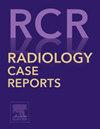中弓状韧带综合征患者胰十二指肠动脉瘤破裂的血管内治疗
Q4 Medicine
引用次数: 0
摘要
胰十二指肠动脉瘤是一种在内脏循环中少见的血管实体,但即使动脉瘤很小,它也有很高的破裂和危及生命的出血风险。我们报告一个病例57岁的男性谁提出了急性胃痛和低血容量性贫血的迹象。增强计算机断层扫描显示一个大的腹膜后血肿与胰脏十二指肠动脉多发动脉瘤有关。值得注意的是,腹腔动脉表现出特征性的弓形正中韧带压迫,与弓形正中韧带综合征(MALS)一致。患者使用纤维线圈和n -氰基丙烯酸丁酯-脂醇混合物进行紧急血管内栓塞,使动脉瘤段完全闭塞,临床迅速稳定。本病例强调了横断成像在识别潜在血管异常(如MALS)中的关键作用,并强调了选择性血管内栓塞治疗复杂内脏动脉瘤的有效性和安全性。长期随访对于发现与肠系膜血流动力学改变相关的潜在复发或器官缺血是必要的。本文章由计算机程序翻译,如有差异,请以英文原文为准。
Endovascular management of a ruptured pancreaticoduodenal artery aneurysm in a patient with median arcuate ligament syndrome
Pancreaticoduodenal artery aneurysm is an uncommon vascular entity within the visceral circulation, yet it carries a high risk of rupture and life-threatening hemorrhage, even when the aneurysm is small. We report a case of a 57-year-old male who presented with acute epigastric pain and signs of hypovolemic anemia. Contrast-enhanced computed tomography revealed a large retroperitoneal hematoma associated with multiple aneurysms arising from the pancreaticoduodenal arteries. Notably, the celiac artery demonstrated characteristic compression by the median arcuate ligament, consistent with median arcuate ligament syndrome (MALS). The patient underwent emergency endovascular embolization using a combination of fibered coils and N-butyl cyanoacrylate–Lipiodol mixture, resulting in complete occlusion of the aneurysmal segments and rapid clinical stabilization. This case underscores the pivotal role of cross-sectional imaging in identifying underlying vascular anomalies such as MALS and highlights the efficacy and safety of selective endovascular embolization in managing complex visceral aneurysms. Long-term follow-up is essential to detect potential recurrence or organ ischemia related to altered mesenteric hemodynamics.
求助全文
通过发布文献求助,成功后即可免费获取论文全文。
去求助
来源期刊

Radiology Case Reports
Medicine-Radiology, Nuclear Medicine and Imaging
CiteScore
1.10
自引率
0.00%
发文量
1074
审稿时长
30 days
期刊介绍:
The content of this journal is exclusively case reports that feature diagnostic imaging. Categories in which case reports can be placed include the musculoskeletal system, spine, central nervous system, head and neck, cardiovascular, chest, gastrointestinal, genitourinary, multisystem, pediatric, emergency, women''s imaging, oncologic, normal variants, medical devices, foreign bodies, interventional radiology, nuclear medicine, molecular imaging, ultrasonography, imaging artifacts, forensic, anthropological, and medical-legal. Articles must be well-documented and include a review of the appropriate literature.
 求助内容:
求助内容: 应助结果提醒方式:
应助结果提醒方式:


